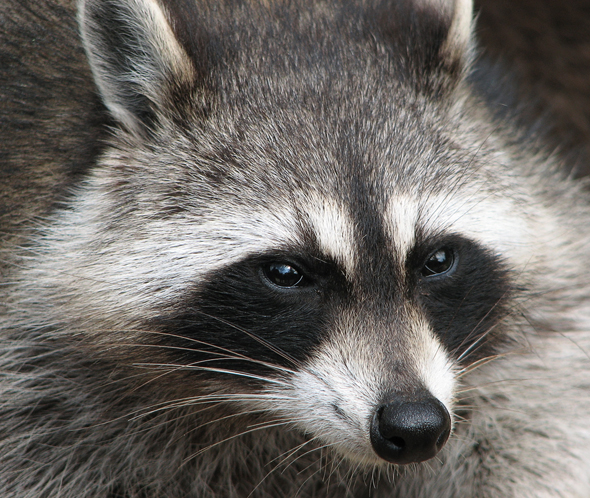
Common Raccoon (Procyon lotor). Image courtesy of Wikimedia Commons and Darkone.
According to a recent story in The Charleston Gazette, the U.S. Department of Agriculture has, in recent years, made great strides in stopping the westward spread of the raccoon variant of the rabies virus. And a promising new vaccine, typically distributed in packets dropped from airplanes, may eliminate raccoon rabies altogether.
The news came via a presentation by Richard Chipman, Assistant National Rabies Management Coordinator for USDA’s Wildlife Services (yes, that Wildlife Services), and several of his colleagues at the Northeast Association of Fish and Wildlife Agencies’ Conference in April.
“Chipman said the vaccine, called ONRAB, has helped eliminate raccoon rabies in the Canadian province of Quebec. He also said that tests last year in southern West Virginia showed it to be even more effective than V-RG, the vaccine currently being used.” [1]
According to an abstract posted on the NEAFWA website, field trials began last September and Wildlife Services “anticipate[s] expanding trials in FY 2012 to strategic areas for further evaluation toward broader geographic use of this vaccine in the future.”
This is big news for TNR advocates, as a report of 2010 rabies surveillance data complied by the Centers for Disease Control and Prevention (from which the map below was taken) explains: “Most (82.2 percent) of the 303 rabid cats were reported from states where raccoon rabies was enzootic, with two states (Pennsylvania and New York) accounting for nearly a third of rabid cats reported during 2010.” [2]
[Note: As the report makes clear, “because of difference in protocols and submission rates among species and states, comparisons of the percentages of rabid animals between species or states are inappropriate.” [2] Unfortunately, TNR opponents often overlook or ignore this important caveat.]

“Raccoon rabies,” explains Gazette reporter John McCoy, “first showed up in 1953 in Florida, and spread approximately 35 miles a year after that.”
“Chipman said the disease’s advance jumped dramatically in the mid-1970s when hunting clubs imported raccoons from infected areas in the Deep South to an area along the Virginia-West Virginia border. The disease spread rapidly northeastward after that, and now is found along the entire East coast from Florida to Maine.” [1, emphasis added]
I haven’t looked into the hunting connection just yet, but let’s assume for the moment that McCoy’s correct about that. The raccoon variant of the rabies virus that’s been associated geographically with 82.2 percent of rabies cases in cats—as well as 88.1 percent of cases in foxes [2]—can be traced to careless hunting practices?
Well, that might explain why the story hasn’t been picked up by The Wildlife Society, which endorses hunting, “when properly regulated following biological principles, [as] an appropriate means of managing wildlife populations.” [3] This, of course, is the same organizations whose CEO/executive director was, just last month, blaming (without, it seems, the burden of even the most cursory research) feral cats for a rabies “outbreak” around Carlsbad, NM.
In fact, the source was a rabid skunk inadvertently trapped by a TNR group. [4]
No mention of the ONRAB story by the American Bird Conservancy, either—perhaps because their “concern” for rabies begins and ends with free-roaming cats.
As I say, I’ve yet to dig into McCoy’s claim about hunters “importing” raccoon rabies into the mid-Atlantic states 40 years ago. If true, it begs the question: Was there any opposition from the various organizations now so eager to play the rabies card in their witch-hunt against feral cats?
Stay tuned.
Literature Cited
1. McCoy, J. (2012, May 24). Researches closer to eliminating raccoon rabies. The Charleston Gazette, from http://wvgazette.com/Outdoors/201205190101
2. Blanton, J.D., et al., “Rabies surveillance in the United States during 2010.” Journal of the American Veterinary Medical Association. 2011. 239(6): p. 773–783. http://www.ncbi.nlm.nih.gov/pubmed/21916759
3. n.a., Final Position Statement: Hunting. 2010, The Wildlife Society: Bethesda, MD. http://joomla.wildlife.org/documents/positionstatements/07-Hunting.pdf
4. Smith, M. (2012, April 14). Rabies outbreak suspends Feral Cat Program. Carlsbad Current-Argus.
